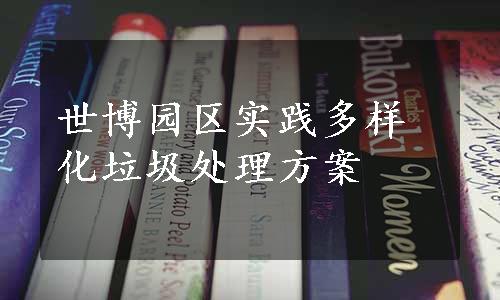
Classification of Construction Wastes
世博园区建筑垃圾多途径再生利用
Various Ways of Waste Recycling in the Expo Area
世博园区原是上海重工业分布的城市旧区,也是城市滨水中心区,区域内的江南造船厂、爱德华造船厂、上海钢铁三厂、港口机械厂和上海溶剂厂等是有着100多年历史的大型企业。世博园区范围内的大量旧建筑需要拆除,短时间内将会产生体量庞大的建筑垃圾。
Shanghai World Expo was built at the old district dominated by heavy industries in previous years. It is also a waterfront place where large enterprises with over 100 years’ history were distributed, such as Jiangnan Shipyard,Edward Shipyard, the Third Steel Factory, Port Machinery Factory, Shanghai Solvent Plant, etc. In the Expo area,a large number of old buildings should be pulled down, leaving a large amount of construction waste in a short time.
据统计,13家主要企业总占地面积320万平方米,总建筑面积140万平方米,总道路面积210万平方米,总绿地面积13万平方米,总围墙长度45 000米,构筑物产生垃圾量220万吨,围墙产生垃圾总量7万吨,道路产生垃圾总量66万吨,拆迁建筑垃圾总量290万吨。依据建筑垃圾可能的资源化途径,将拆迁建筑垃圾中处理或利用方式相似的项进行合并,由此将拆迁建筑垃圾分为:废钢、废混凝土砂石(水泥、石灰、砂、砾石)、废玻璃、废砖块和可燃废料(废木材、废油毡、废沥青)。其中废混凝土砂石产生量228万吨,占总建筑废弃物的80%;废砖产生量17万吨,占总建筑废弃物的17%;其他建筑废弃物约9.3万吨,占总建筑废弃物的3%。
According to statistics, 13 major enterprises covered an area of 3.2 million m2. Their overall floorage amounted to 1.4 million m2, total road area 2.1 million m2, total green area 130 000 m2, total enclosure wall length 45 000 m. The total amount of garbage generated by structures reached 2.2 million tons, enclosure wall 70 000tons, the roads 660 000 tons and the demolition of buildings 2.9 million tons. Given the possible recycling ways of construction waste, the demolition waste was classified in terms of the similarities of dealing with waste or reuse value. Thus, the waste of demolition was divided into five major categories: steel scrap, waste concrete (cement,lime, sand, and gravel), waste glass, waste bricks and combustible waste (waste wood, waste linoleum, waste asphalt). Among them, waste concrete produced were 2.8 million tons, accounting for 80% of total construction waste, waste brick 170 000 tons, 17% of total, other construction waste about 93 000 tons, 3% of total.
废混凝土再生利用技术
Recycling Technology of Waste Concrete
用手工方法除去废钢筋、废木料等杂质,用电磁分离法除去铁质杂质等。二次破碎后要求达到的物料粒径小于40毫米,其中粒径在10~40毫米之间的再生物料称作粗骨料,多应用于拌制再生混凝土和工程基础回填;小于1毫米的再生物料为细骨料,主要用于生产透水材料、再生多孔砖和混凝土砌块等。
Impurities such as waste rebar and waste wood are removed by hand, while irony substance and other impurities are taken away by electromagnetic separation. Materials are required to be less than 40 mm in particle size after secondary breaking. Recycling material with particle size between 10~40 mm is called coarse aggregate,which is usually used for concrete mixing and backfilling of foundation. However, fine aggregate, the particle size of which is less than 1 mm, is applied in the production of permeable materials, perforated bricks and concrete blocks.
废玻璃再生利用技术
Recycling Technology of Waste Glass(www.xing528.com)
废玻璃主要产生于选择性拆毁过程,拆除的废玻璃主要通过卡车运送到玻璃厂进行再生利用。与铝合金及其他金属混合的玻璃可以通过静电鼓式分离机将含在玻璃中的少量金属分离出来,一般经过3次以上即可将含在玻璃中的金属基本分离干净,再通过磁流体分选技术将玻璃中的剩余金属全部分离,剩下的即为纯度很高的玻璃原料。
Coming from selective demolition, waste glasses are mainly transported to the glass plant by truck for recycling. Glasses mixed with aluminum alloy and other metals could be separated by electrostatic drum separator. Generally, the metals could be cleanly separated from glasses for three times. With magnetic separation technology, metals could be completely separated from glass, leaving raw glass with high purity.
废木材再生利用技术
Recycling Technology of Waste Wood
利用废弃木材制作纤维板:废弃木材经过刨片、热磨(温度160~180℃,蒸汽压力1~1.2兆帕),其包间层会发生爆裂,达到软化和解纤,再制成浆料,将获得一定细度的浆料在打浆池内打浆,同时加入2%~3%的酚醛树脂(或其他胶黏剂)和沉淀剂,将树脂沉淀在纤维上,在氢键和各种分子结合力等的作用下经热压结合成纤维板。原料配比为废弃木材制成的纤维(干)85%~90%,酚醛树脂2%~5%,硫酸铝1%~1.5%,石蜡1%~1.5%。
Fiberboard could be made from waste wood: waste wood goes through the process of the flaking, hot mill(temperature 160~180℃, steam pressure 1~1.2 MPa). After the crack of the inner layer, the wood will be softer and defibrillated, and is finally made into pulp. 2%~3% phenolic resin (or other adhesives) and precipitator are poured into the pool where fine pulp is refining. Make sure that the resin precipitates on the fiber. Given the binding force from hydrogen bond and a variety of molecular, the waste wood turns into fiberboard by hot pressing. The ratio of raw material fiber (dry) made from the waste wood is 85%~90%, phenolic resin 2%~5%,aluminum sulfate 1%~1.5%, paraffin 1%~1.5%.
利用废弃木材制作中密度纤维板:采用和纤维板相同的预处理工艺,只是热磨步骤之后,纤维不浸入打浆池打浆,而采用干法在管道中施胶和在管道中干燥,纤维得率高,板材施脲醛胶,施胶量大,板材两面光。原料配比为废木料制成的纤维82%~85%,低甲醛脲醛树脂12%~15%,氯化铵0.5%~1%,石蜡1%~2.5%。
Medium density fiberboard could be made from waste wood: after the same pretreatment process as the fiberboard and hot mill, do not dump the fiber into the pulp pool for refining. Instead, add adhesives and dry them in the pipeline to achieve high yield of fiber. Give large amount of urea-formaldehyde glue to make sure that both side of the board are smooth. Raw material fiber (dry) made from the waste wood 82%~85%, urea formaldehyde resin with low formaldehyde 12%~15%, ammonium chloride 0.5%~1%, paraffin 1%~2.5%.
我国城市垃圾堆填区的建设速度难以跟上垃圾的增长速度,城市正面临垃圾围城的窘境,垃圾污染日益严重,已经成为我国政府高度重视和致力解决的重大社会问题之一。世博园区的建筑废弃物资源化再利用给我们带来了重要的启示。
Since China’s development of landfill in cities is unable to keep pace with the increasing heap of garbage,cities are facing the problem of “being besieged by waste”. And Chinese government has attached great emphasis to this growing issue, and has been devoted to solving it. We are inspired by the recycling of construction waste in the Expo area.
(Contributed by Tongji University, sorted by Qi Lingyun)
免责声明:以上内容源自网络,版权归原作者所有,如有侵犯您的原创版权请告知,我们将尽快删除相关内容。




